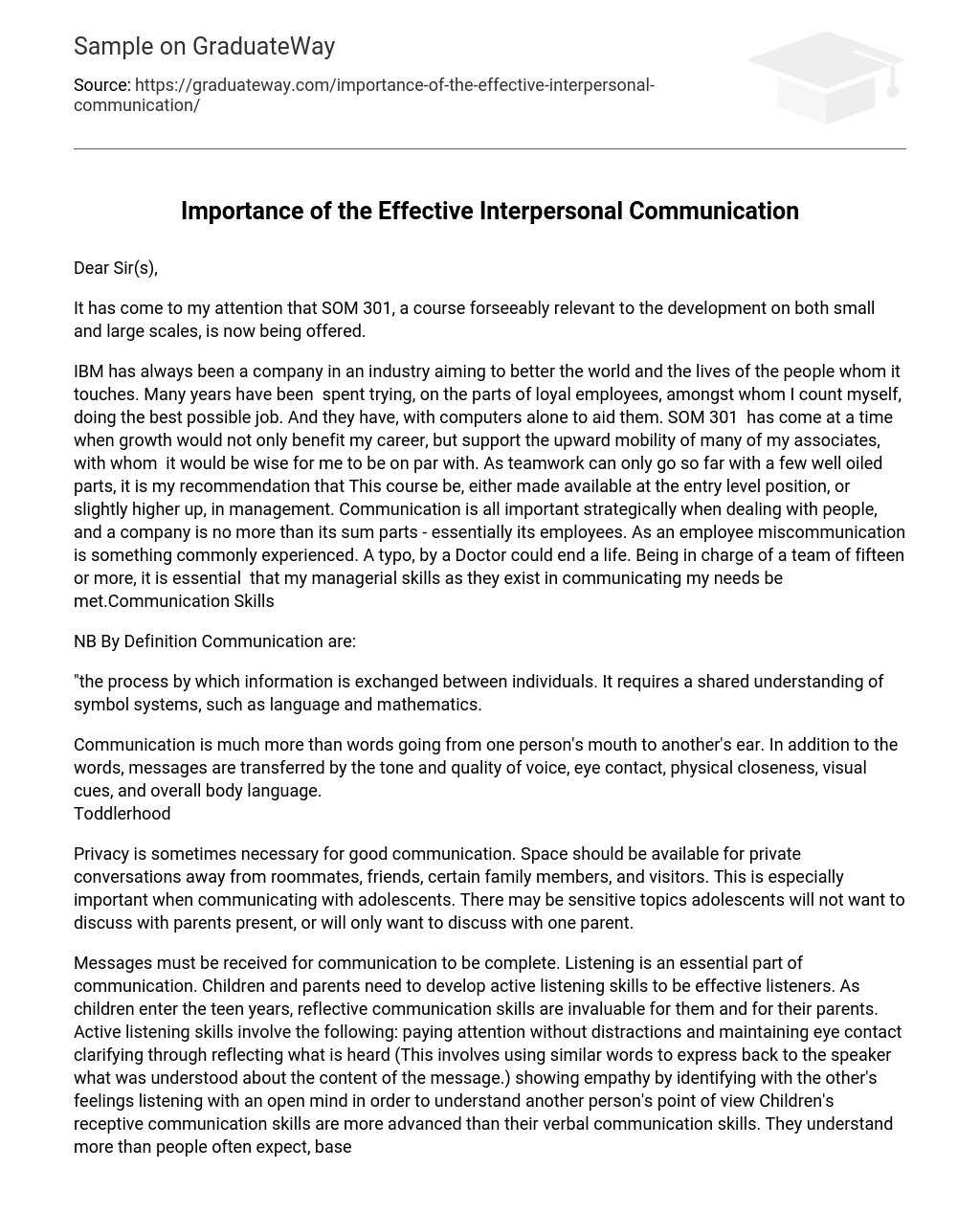IBM has always been a company in an industry aiming to better the world and the lives of the people whom it touches. Many years have been spent trying, on the parts of loyal employees, amongst whom I count myself, doing the best possible job. And they have, with computers alone to aid them. SOM 301 has come at a time when growth would not only benefit my career, but support the upward mobility of many of my associates, with whom it would be wise for me to be on par with.
As teamwork can only go so far with a few well oiled parts, it is my recommendation that This course be, either made available at the entry level position, or slightly higher up, in management. Communication is all important strategically when dealing with people, and a company is no more than its sum parts – essentially its employees. As an employee miscommunication is something commonly experienced. A typo, by a Doctor could end a life. Being in charge of a team of fifteen or more, it is essential that my managerial skills as they exist in communicating my needs be met.
NB By Definition Communication are: “the process by which information is exchanged between individuals. It requires a shared understanding of symbol systems, such as language and mathematics. Communication is much more than words going from one person’s mouth to another’s ear. In addition to the words, messages are transferred by the tone and quality of voice, eye contact, physical closeness, visual cues, and overall body language.
Privacy is sometimes necessary for good communication. Space should be available for private conversations away from roommates, friends, certain family members, and visitors. This is especially important when communicating with adolescents. There may be sensitive topics adolescents will not want to discuss with parents present, or will only want to discuss with one parent.
Messages must be received for communication to be complete. Listening is an essential part of communication. Children and parents need to develop active listening skills to be effective listeners. As children enter the teen years, reflective communication skills are invaluable for them and for their parents.
Active listening skills involve the following: paying attention without distractions and maintaining eye contact clarifying through reflecting what is heard (This involves using similar words to express back to the speaker what was understood about the content of the message.) showing empathy by identifying with the other’s feelings listening with an open mind in order to understand another person’s point of view Children’s receptive communication skills are more advanced than their verbal communication skills. They understand more than people often expect, based on their verbal skills. Effective parents talk with their children, not to them. To engage children in conversation, parents can ask open-ended questions and not judge what their children say.
People communicate with eyes as well as ears. Communication occurs with cues of body language and facial expression. Eye contact is a communication connector. Making eye contact helps confirm attention and interest between the individuals communicating.
Some people are visual learners. They learn best when they can see or read instructions, demonstrations, diagrams, or information. Using various methods of presenting and shaping information increases understanding. Photographs, videotapes, dolls, computer programs, charts, and graphs can as effectively communicate information as written or spoken words can.
Open body stance and positioning invite communication and interaction, whereas a closed body stance and positioning impedes communication. Using an open body posture improves communication with children. Both parents and children learn to read each other’s body language. Timing Recognizing the right time to communicate is a skill. A distraught child whose parents have left for work is not ready to hear a story. The time will be more productive and the information better received if the child has a chance to make an emotional transition.
Parents should strive to make words and intended meanings match when communication with their children. Children who are given mixed messages are confused and uncertain. Sometimes parents unwittingly attempt to control their children with double or mixed messages; doing so is unhealthy for their relationship to one another.
There are various kinds of spoken language problems, delays, and disabilities. In general, experts distinguish between those children who are slow in developing spoken language (language delay) and those who have difficulty achieving a milestone of spoken language (language disorders). Language disorders include stuttering; articulation disorders, such as substituting one sound for another (tandy for candy); omitting a sound (canny for candy); or distorting a sound (shlip for slip). Voice disorders include inappropriate pitch, volume, or quality. The causes for language problems have been linked to hearing, nerve, and muscle disorders; head injury; viral diseases; mental retardation; drug abuse; and cleft lips or palate.”
That having been said, miscommunication of the slightest can have grand reprecussions. To enable the best possible performance most employees, myself formost, would benefit from this class. This is probably why Dale Carnegie has turned such a simple thing into an empire. In its simplest terms, bad communication is like a game of broken telephone. It can be funny but with disastrous consequences.
Books
- DeVito, Joseph A. Human Communication. Old Tappan, NJ: Allyn & Bacon Inc., 2005.
- Nixon, Caroline. Primary Communication Box: Reading Activities and Puzzles for Younger Learners. Cambridge, UK: Cambridge University Press, 2005.
- Segrin, Chris, et al. Family Communication. Mahwah, NJ: Lawrence Erlbaum Associates, 2005.





